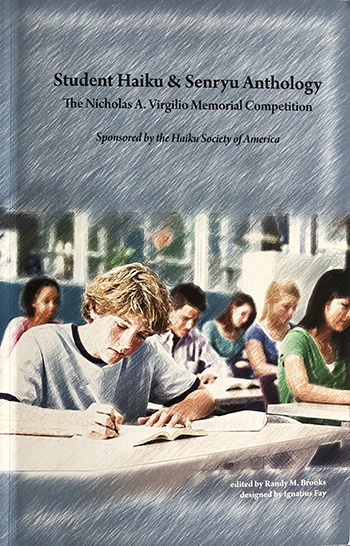Haiku Society of America Student Haiku Awards
in Memorial of Nicholas A. Virgilio
~ ~ ~
Student Haiku Awards for 2008
Tony Pupello and Pamela Miller Ness
judges
We would like to express our appreciation to all the young poets who submitted to this year’s contest and to the teachers who instructed them in the craft and special characteristics of haiku. It was a privilege to be invited to enter their haiku moments and a pleasure to share their imagery and language. Each of us first read and re-read the 85 submissions numerous times; we then met to discuss our preliminary selections and to undertake the challenging task of selecting six poems (unranked) that we consider most exemplary of fine haiku. And it was a challenging task. Many of the entries were sophisticated in their use of imagery and juxtaposition and were very proficiently crafted. As with very fine haiku and senryu, many were layered and functioned on multiple levels.
Of course, while any finalist must exhibit many of the salient characteristics of haiku, we also looked for poems that surprised or delighted us and expanded our experience through imagery, language, and/or emotional resonance. As R. H. Blyth wrote, “A haiku is the expression of a temporary enlightenment, in which we see into the life of things” (Haiku, volume 1). ~ Tony Pupello and Pamela Miller Ness
winter stars
my father paints over
the old white wallsAsha Bishi
School of the Arts, Age 18, 12th grade, Rochester, NYThe poet subtly creates multiple layers of juxtaposition: interior and exterior; the white of snow, stars, and walls; and a single human being within the vast universe. S/he captures essential elements of classical Japanese haiku, yugen (mystery) and sabi (essential aloneness) and leaves the reader with an unfinished narrative. It is the reader’s job to enter into this powerful and mysterious haiku to complete the story.
autumn night
one brick
darker than the restGracie Elliot
School of the Arts, Age 12, 7th grade, Rochester NYThis poet also sets the scene with a kigo, autumn night, suggesting the various connotations of autumn; a time of change, shorter days, and the onset of cold weather. S/he effectively juxtaposes the vastness of a night sky with a single human-made brick and the darkness of the night with one dark brick. The combined imagery of the night sky and the fact that all the bricks are dark give this poem a deeply melancholy mood. There is no light except for the illumination of the poet’s keen observation and beautifully crafted language, the crispness of the night so carefully reflected in the repetition of t’s and k’s.
first kiss —
the tingle of coke
down her throatLauren Fresch
Perkins High School, Age 17, grade 12, Sandusky, OHThis is an excellent example of a contemporary senryu: ingenuous, humorous, and at the same time deeply moving. How perfectly the poet captures first love through such specific sensory imagery, a kiss shared over a coke, both of which tingle in her throat. This poet should also be commended for his/her carefully crafted language: the alliteration of kiss and coke, the onomatopoeic use of kiss and tingle, and the assonance of coke and throat.
scent of spring
my sister paints
the rising sunAsha Bishi
School of the Arts, Age 18, grade 12, Rochester, NYThis is an excellent example of how what might be a trite kigo expression, “scent of spring,” is used as the springboard to a delightful, lovely and spare moment. A moment of fragrant breezes combined with the lightness and brightness of the rising sun—a moment that may be overdone—is turned into a real moment of spring bursting forth found in the act of “sister painting.” This poem turns on the unselfishness of the author—sharing this moment of creation with her/his sister and sharing sister’s creation with us. And this glorious moment of rebirth and renewal is presented in very simple, understated terms.
silent graveyard
one tombstone
with a crowAlexa Navarez
School of the Arts, Age 12, grade 7, Rochester, NYA deeply evocative poem, this piece resonates in the absence of sound. A “silent graveyard” is a commonplace and perhaps overdone image. After all, what is a graveyard if not silent, if not the absence of sound and the activity of life? Yet oft-times we, the living, disturb the graveyard’s silence with our own intrusions. Perhaps uncomfortable we chatter, we joke, we stir. In this piece the poet has succeeded in capturing and reinforcing the disturbing silences. The normally rambunctious and extremely loud crow sits silently in stillness atop a tombstone—forcing us, the readers, to put aside all and become part of that most uncomfortable silence.
light footsteps
across the snow
his alcohol breathDesire Giddens
School of the Arts, Age 12, grade 7, Rochester, NYThe lightness of the snow, and the heaviness of alcoholism. These are two elements the poet deftly weaves together for us in this finely crafted poem. At first, we are confronted with an air of untruth, anathema in haiku. How could anyone who’s drunk step lightly? Drunks are heavy, have uncontrollably heavy movements, and are not graceful in the least. Aren’t they? Once again, the reader is called, pulled, into the narrative. This is not an attempt at a desktop haiku, an image written because it fits right in the author’s imagination. This is a sad piece about an all-too-common disease. The author is painfully aware of how graceful, how light an alcoholic can appear on the surface. Yes, the drunk passes over almost unnoticed, certainly his light footsteps do not give him away – but his breath does.
~ ~ ~
